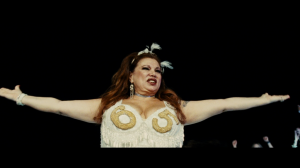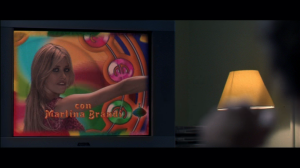Cinepanettone- Academia
The Showgirl Effect: Ageing between great beauties and ‘veline di turno’
by Danielle Hipkins (University of Exeter)
Once we bring gender theory seriously into play in media criticism, it topples hierarchies and comfortingly familiar modes of categorization. For this reason it is all too often kept hovering in the wings of Italian screen studies. Alan O’Leary’s study of the ‘cinepanettone’ does a great deal to remedy that by highlighting the way in which the genre’s abject status is often reinforced by and placed on a par with the figure of the ‘velina’ or television showgirl, who is a standard trope within the films.[1] O’Leary shows how her function here is most often read as debasing to women, as contaminating the genre further through the female actors’ origins in the despised medium of television and all its associated particular political problems, and with the women’s frequently semi-naked appearance as object of the male gaze. It is worth remembering that for international film audiences, however, this particular vision of women is familiar not so much from Italian television, or the ‘cinepanettone’, as from Italy’s tradition of art-house cinema, such as the opening scene of La dolce vita (Fellini, 1960). Such a use of the female body formed, and continues to form, part of the international appeal of Italian cinema, although the growing visual presence of bikini-clad women on Italian television is almost universally deplored.
Indeed the figure of the showgirl herself lay at the fantasy heart of Fellini’s landmark film, Otto e mezzo (1963), in which Fellini’s alter ego, Guido, banished an ageing showgirl from his imagined harem in order to preserve his own fragile empire. If it is this act that triggered the mutiny amongst his hitherto adoring female entourage, the tongue-in-cheek presentation of this displacement of the ageing process onto the female body was nonetheless allowed to stand, and the female spectator, as Aine O’Healy has written of the much later film La voce della luna (1990), ‘is forced to contemplate her own desire mirrored as grotesque and unspeakable’[2] in the portrayal of women as abject. Such a gendered figuration of ageing re-emerges in the recent La grande bellezza by Paolo Sorrentino (2012). Hailed as part of the ‘re-birth’ of Italian cinema, Sorrentino’s intense evocation of Fellini’s Rome expresses nostalgia for and an attempted re-instantiation of the same gender dynamic. The female character is, once again, made to carry the burden of corporeal ageing, like the (feminized) body of Rome itself, whilst male ageing is a question of redeeming soul and memory, in which the male melodrama of Jep’s suffering, as Catherine O’Rawe describes in her forthcoming book on masculinity in contemporary Italian cinema, becomes ‘the gateway to the sublime’.[3] The overweight showgirl bursts into the film from the cake at Jep’s sixty-fifth birthday party, re-appearing several times, portrayed as grotesque and desperate, explicitly marked for the twenty-first century audiences as a former TV ‘velina’. One significant scene in which she appears takes place in a fantasy beauty salon, where this ‘Saraghina’ figure is reprimanded by the salon owner for having betrayed her course of botox treatment by seeing another beautician. In interview, Serena Grandi, the former erotic film star who plays this figure, admits that at first she was angry with the portrayal of her character, but later she was able to ‘metabolizzare’ her discomfort.[4]
The use of these Felliniesque ‘female grotesques’ is utterly in keeping with a desire to preserve comforting (for whom?) gendered typologies. The question of female display is central to Sorrentino’s film. As the secret of Jep’s blocked creativity reveals, the revelation and preservation of sexual difference is this film’s fetish, from the opening focus on the female strippers who form a silent backdrop to the party, to the protagonist’s only meaningful relationship with a woman: Sabrina Ferilli’s ageing stripper. Female beauty represents what is cancerous, what is mortal, what is best when it has been transformed into art. As Elizabeth Bronfen has shown, the dead woman is the foundational myth of male creativity,[5] but female spectators and actors must, like Grandi, simply ‘metabolizzare’.
Returning to the ‘cinepanettone’, O’Leary has argued that far more emphasis is placed on the display of male bodies than female bodies in the genre, and these bodies are all rendered carnevalesque in their transgression of normative physical boundaries. Certainly, as O’Leary highlights, the moralizing approach to cosmetic surgery, so evident in Sorrentino’s film, is absent from the ‘cinepanettoni’, which positively endorse the practice in a playful manner that extends to both genders. Nonetheless the appearance of the showgirl body is used still to address questions of ageing. Here, rather than projecting the terror of ageing onto a vision of a female body that is decaying, obese, out of control, dead or dying, the films use the idealized, youthful perfection of the ‘velina’ body as a different form of gender discipline. There are examples of ‘cinepanettoni’ in which this figure teaches the ageing male protagonist to return to, or find, a woman his own age. This is sometimes in conjunction with the male protagonist’s daughter, whose proximity in age to the ‘velina’ figure acts as a reminder of the incest taboo that marks cross-generational fantasies. In Christmas in Love (Neri Parenti, 2004), for example, it is Massimo Boldi’s character’s repeated rage against his daughter’s (Cristiana Capotondi) (faked) relationship with the Danny De Vito character that slowly makes his own young girlfriend, played by successful TV presenter Alena Seredova, realize that their relationship is doomed, returning Boldi to the arms of his middle-aged wife. In other, less successful, copycat examples of the genre, such as Commediasexi (D’Alatri, 2006), the ‘velina’ teaches the older generation, male and particularly female, to shape up and conform to new ways of managing relationships.
When Dora (Margherita Buy) suspects her husband of an affair with the TV star, ‘la trottola’, played by showgirl Elena Santarelli, she seeks out a ‘do-over’, the classic postfeminist dream embodied by the women of Sex and the City, in which it appears that consumerism can always offer women the opportunity for self-renewal. Thus Dora is able to revivify and consolidate her role within the conservative institution of marriage.
These messages coming from the ‘cinepanettoni’ and its satellite films are all inevitably more and less conservative messages about gender and ageing, but in their relatively even-handed address to both genders, and their comic emphasis on survival, they are far from the brutal misogyny of a different line of Italian filmmaking: internationally revered art-house cinema. Gender theory does indeed require us to revise canons of film-making, but we still appear reluctant to do so.
[1] Alan O’Leary, Fenomenologia del cinepanettone (Soveria Mannelli: Rubbettino, 2013).
[2] Aine O’Healy, ‘Unspeakable Bodies: Fellini’s female grotesques’, Romance Languages Annual 4 (1992), pp. 325-29 (329).
[3] Catherine O’Rawe, Stars and Masculinities in Contemporary Italian Cinema (New York: Palgrave Macmillan, forthcoming).
[4] http://cinema-tv.corriere.it/cinema/13_giugno_12/cappelli-serena-grandi_ed325ee0-d33e-11e2-b757-6b1a3e908365.shtml, accessed November 12th, 2013.
[5] Elizabeth Bronfen, Over Her Dead Body: Death, femininity and the aesthetic (Manchester University Press, 1992).
Danielle Hipkins is Senior Lecturer in Italian at the University of Exeter. She is the author of Contemporary Italian Women Writers and Traces of the Fantastic: the creation of literary space, (London: Legenda, 2007). Her research focuses on issues of post-feminism and prostitution in Italian cinema and culture, on which she has published articles and book chapters including ‘“Whore-ocracy”: Show girls, the beauty trade-off, and mainstream oppositional discourse in contemporary Italy’, Italian Studies 66, no. 3 (2011). She has recently co-edited (with Roger Pitt) the book Re-envisioning the Child in Italian Cinema (Oxford: Peter Lang, 2013), to which she has also contributed with the study Lost Girls: Daughters of sin in Italian melodrama.



